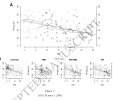Andy
Senior Member (Voting rights)
Abstract
Prepulse inhibition reflects subcortical sensory integration, where a low-intensity peripheral stimulus (prepulse) reduces the amplitude of a reflex response to a subsequent high-intensity stimulus. As a measure of pre-attentive sensory gating, prepulse inhibition has been found to be altered in small cohorts of patients with functional disorders, including functional motor disorder and fibromyalgia, suggesting a shared deficit in sensory information processing. However, prior studies have not demonstrated consistent associations between prepulse inhibition abnormalities and clinical measures.We hypothesized that widespread pain and somatic symptoms in somatic symptom disorders may result from a general deficit in the interpretation of bodily signals, potentially linked to abnormalities in sensory filtering as measured by prepulse inhibition.
In this study, we examined 140 participants across four age- and sex-matched groups: 35 patients clinically categorized with functional motor disorder without fibromyalgia, 35 with both functional motor disorder and fibromyalgia, 35 with fibromyalgia only, and 35 healthy controls. A weak electrical stimulus to the index finger served as the prepulse, delivered 100 ms before supraorbital nerve stimulation to elicit the R2 component of the blink reflex. Prepulse inhibition was calculated as the percent reduction in R2 amplitude.
Across all groups, lower prepulse was significantly associated with higher scores on the Fibromyalgia Severity Scale, consisting of Widespread Pain Index and Symptom Severity Scale. In patients with functional motor disorder, no association was found between prepulse inhibition size and objectively rated motor symptom severity.
These findings suggest that impaired early sensory processing at subcortical level is related to “fibromyalgianess” in people with functional motor disorder and fibromyalgia. Abnormal prepulse inhibition may serve as an objective transdiagnostic marker of fibromyalgia symptomatology or fibromyalgianess, including widespread pain and other non-motor symptoms in functional disorders, highlighting a potential role of sensory gating deficits in the pathophysiology of fibromyalgia-spectrum manifestations.
Open access

